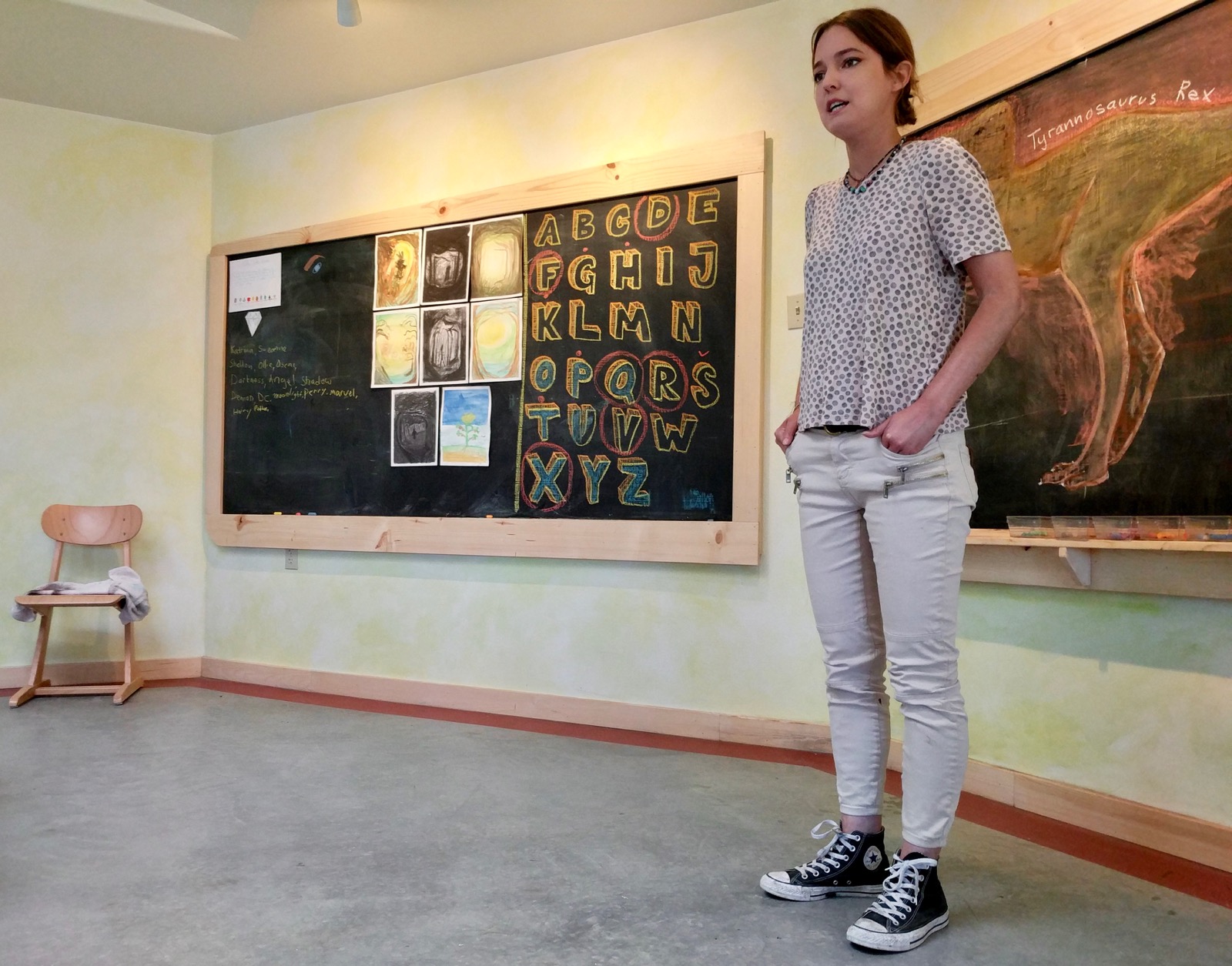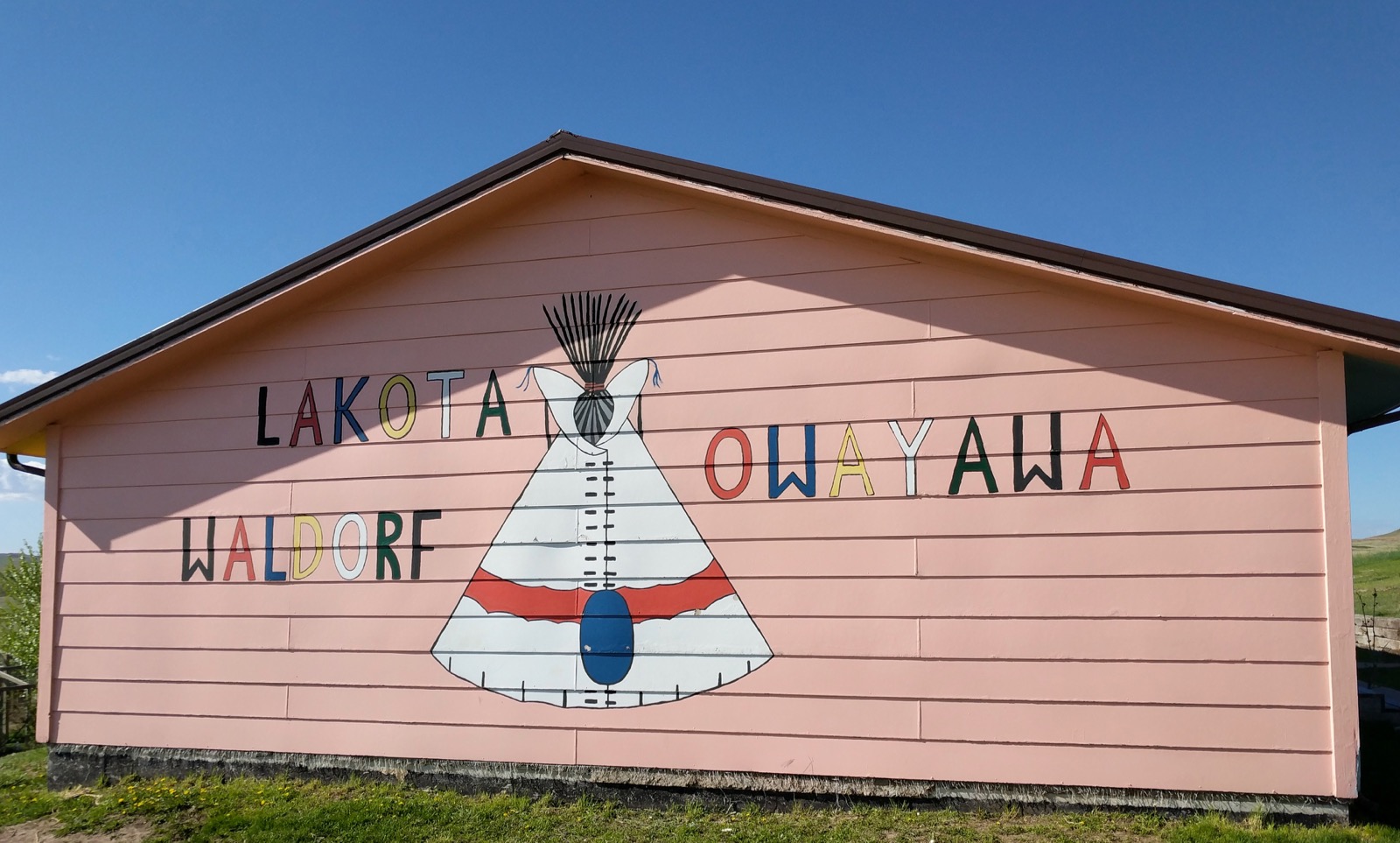'We teach them their culture, give them their cultural identity'
Lakota Waldorf School educates youth on Pine Ridge ReservationBy Kevin Abourezk
@Kevin_Abourezk KYLE, South Dakota – The girl with the braids strikes a match. Without hesitation, she holds the flame to a sage bundle until the whitish-green leaves catch fire, sending smoke billowing into the air as three fellow students and two teachers standing in a circle beside her watch. She carries the smoking bundle around the circle, stopping briefly before each person as they each reach into the smoke and brush it up toward their heads, trying to fan the smoke into their hair. The hair is a source of power to the Lakota people, and the smoke from burning sage is a purifying medicine. As the smoke slowly rises inside the warm light of the classroom, songbirds whistle outside, and a man begins a prayer song. As the girl finishes, she places the burning sage bundle into the conch shell and lays the shell on a buffalo hide at her feet. The man ends his song and says a prayer of thanks to start the day at the Lakota Waldorf School. “Mitakuye oyasin,” the students and their teachers say. We are all related.

Celestine Stadnick is a 27-year-old citizen of the Oglala Sioux Tribe whose mother is a Swiss citizen and founder of the Lakota Waldorf School. Celestine is the school’s third- through sixth-grade teacher. She said she sees the effects of the boarding schools in her students, many of whom are being raised by their grandparents. People who haven’t lost their culture through genocide don’t understand the trauma that such an event can inflict on generations of indigenous people, Celestine said. Catholic Jesuits founded the first boarding schools in the 17th Century in Maryland for the purpose of civilizing Native people and converting them to Christianity. Eventually, the federal government found purpose in the idea and founded its own boarding schools. Richard Henry Pratt, an Army officer, founded one of the first government boarding schools, the Carlisle Indian Industrial School in Carlisle, Pennsylvania. According to Pratt, the school’s mission was to “kill the Indian in him and save the man.” Later, the government founded other boarding schools on reservations, often paying Christian missionaries to provide instruction at those schools. Like the founder of the Carlisle boarding school, those missionaries saw their goal as killing the Indian inside the man, often at the point of a stick.

Native children were immersed in European-American culture, denied their cultural traditions and deprived of their language. For many of the Lakota, that loss of identity was akin to the death of a loved one, and many never fully recovered. They carried the trauma of that experience for the rest of their lives and neglected to teach their own children how to speak, fearing to do so would make their own children susceptible to the same abuse they had suffered at the hands of missionaries. “All they knew was abuse. They continued giving that on, and the children today are feeling the effects of their grandparents being tortured in school,” Celestine said. “So we have to deal with this right now, and giving them back their culture that has been so violently removed is what gives them a sense of self.” “Nape gluzhazhaye,” the young woman says. Wash your hands.

It’s time for lunch at the Lakota Waldorf School. The children rush in from the playground. A dog sits up from his resting spot beneath a picnic table. They walk into a small cabin, and children start bringing in pots filled with buffalo soup and bowls filled with homemade bread. The children gather in a circle once again. Two of the younger girls say a prayer, and the children start eating.

Waldorf schools seek to teach children to think for themselves rather than to learn to memorize facts and aim to help children find their identities and achieve their highest potential. The schools incorporate art into nearly every subject as a way to bring lessons to life. The schools still follow the academic requirements set forth by public schools but attempt to teach students by showing them what they are learning and letting them experience their lessons with all of their senses. “Waldorf is basically learning with head, hand and heart,” Isabel Stadnick said. At the Lakota Waldorf School, teachers incorporate math into lessons about beading and even archery. A nature hike incorporates lessons about plants and wildlife, and nearly all commands – wash your hands, go play outside, come inside and eat – are given in Lakota in order to teach the students to become comfortable with their language. “Being Lakota is not this ideology that’s far away,” Celestine Stadnick said. “It’s us living right now, right here, as good as we can.”

Today, hundreds of Waldorf schools are spread throughout the world, but only one such school exists on a Native American reservation. But that isn’t the only thing that sets the Lakota Waldorf School apart. It’s also the only Waldorf school that doesn’t charge its student tuition, said Isabel Stadnick. Most of the parents aren’t able to pay tuition, and we wanted to make it accessible for all children,” she said. The school once received most of the funding from donations provided by European donors. Today, it relies primarily on grants from large foundations and individual donors in the United States. The school has 33 students in grades kindergarten through sixth grade and plans to expand to add seventh grade next year, eighth grade the year after that and ninth grade the year after that. The school also has begun raising donations for the second and third phases of its construction plan, which include a community hall, office space, dining room, commercial kitchen and a coffee shop. “I’m most excited about that,” Isabel Stadnick said of the coffee shop. The school hopes to use the coffee shop to generate revenue to support itself. Likely, the coffee shop would offer a daily lunch special.


In addition to classes, the school offers three meals a day for students, including breakfast, lunch and a snack. The school’s food is mostly organic and includes buffalo meat purchased from the Oglala Sioux Tribe. The school also has an organic garden, a playground and a sweat lodge that is used once a week. Santee Witt, a 43-year-old citizen of the Oglala Sioux Tribe, teaches Lakota culture at the school. A minister in the Native American Church, Witt works to incorporate cultural lessons into nearly every aspect of the school’s activities and hosts a daily drum group for boys at the school. He said he worked in a public school before going to work for the Lakota Waldorf School in January. He said cultural education took up just 30 minutes a day and was taught as a separate subject. “Here it’s implemented all day within the teachings within the classroom,” he said.

Kris Carlson, a 71-year-old man from British Columbia, is the school’s first- through second-grade teacher. He said he came to the school in early January to paint the walls of the new classroom building but was asked to stay by Isabel Stadnick when the school lost a teacher. Carlson said he’s always felt an affinity for Native people. “I always thought that was what I was going to be when I grew up, but then I found out you can’t do that,” he said, laughing. “But I have sort of slipped in under the radar here.” He said he appreciates being able to work for a school that doesn’t use government funding, which always comes with conditions. At the Lakota Waldorf School, teachers are able to educate children at their pace. It’s a freedom public school teachers often lack, Carlson said. “We bring them along as they’re ready, not that we let them slack off,” he said. “We can see developmentally where they’re at.”

He said he plans to stay at the school for a while and it’s not because of the cool new classroom building or even the school’s educational philosophy. “If they can come to school and have such a positive attitude about life and about learning, and if you look at what their environment is outside of this school, it’s not exactly idealistic,” he said. “If they can come here and be loving and artistic and musical, then that’s a lesson for the whole world.” “It’s because of the children that I’m here and it’s because of the children that I’m staying.” Celestine Stadnick was born on the Pine Ridge Indian Reservation and graduated from Little Wound School in Kyle before moving to Switzerland with her mother. She attended a Waldorf school in Switzerland and soon became enamored with the school’s educational philosophy. She decided to return to the reservation last August and help her mother. The school’s educational approach is adjustable for each child, rather than uniform for every child like the public school system, she said. The public schools prepare students to become productive members of society. The Lakota Waldorf School teaches students who they are, Celestine Stadnick said. “The children becoming part of the economy is one part of their life,” she said. “We are looking at the children, what does the child need, not what does America need. We teach them their culture, give them their cultural identity, which is their backbone.”
Join the Conversation

